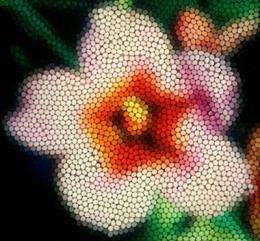June 7, 2012 report
Australian researchers show flower color evolution driven by bee preferences

(Phys.org) -- A team of researchers in Australia has shown that the evolution of flowers in that country was driven by the preferences of bees, rather than the other way around. In their paper published in the Proceedings of the Royal Society B, the team describes how they gathered over a hundred samples of different flowers and then compared them against the types of colors that bees best identify and then compared those results with research findings regarding bees and flowers in North America.
The research team, led by Adrian Dyer, began their study based on research already conducted by other scientists looking to find connections between bees and flower colors in North America. There researchers have found a close connection between flower color and the kinds of colors bees are able to see, and what attracts them.
Then because Australia has been isolated from the rest of the world for millions of years, the team theorized that if the same color patterns emerged independently in such a place, it would prove that the flowers in both places adapted to the bees, and not the other way around. Helping out was prior research that showed that not long after Australia broke away from the other continents some 34 million years ago, the flowers blooming on the island were bland and nearly colorless; which gives researchers a unique opportunity for learning about how coloring in flowers comes about, as today, Australia is teaming with a huge variety of brightly colored flowers.
To find out, the team collected flower samples from 111 native species then studied them using a spectrophotometer (a device that measures different properties of light over a given spectrum). In so doing they found that the studied flowers displayed colors that matched almost exactly with the blue and green ultraviolet vision receptors in bees. And because the results matched those found in North America, the team concluded that the flowers in both places co-evolved in the same way, thus proving that the flowers were reacting and adapting to what the bees were looking for, rather than the bees changing to help them better find the particular flowers that best suited them.
This new research also shows that because flowers have been adapting to suit the taste of bees, rather than for birds or butterflies, bees are the primary means by which flowers are pollinated, which means that as bee populations decline, so too will flowers, and perhaps their rich coloring.
More information: Parallel evolution of angiosperm colour signals: common evolutionary pressures linked to hymenopteran vision, Proceedings of the Royal Society B, Published online before print June 6, 2012, doi: 10.1098/rspb.2012.0827
Abstract
Flowering plants in Australia have been geographically isolated for more than 34 million years. In the Northern Hemisphere, previous work has revealed a close fit between the optimal discrimination capabilities of hymenopteran pollinators and the flower colours that have most frequently evolved. We collected spectral data from 111 Australian native flowers and tested signal appearance considering the colour discrimination capabilities of potentially important pollinators. The highest frequency of flower reflectance curves is consistent with data reported for the Northern Hemisphere. The subsequent mapping of Australian flower reflectances into a bee colour space reveals a very similar distribution of flower colour evolution to the Northern Hemisphere. Thus, flowering plants in Australia are likely to have independently evolved spectral signals that maximize colour discrimination by hymenoptera. Moreover, we found that the degree of variability in flower coloration for particular angiosperm species matched the range of reflectance colours that can only be discriminated by bees that have experienced differential conditioning. This observation suggests a requirement for plasticity in the nervous systems of pollinators to allow generalization of flowers of the same species while overcoming the possible presence of non-rewarding flower mimics.
Journal information: Proceedings of the Royal Society B
© 2012 Phys.Org


















